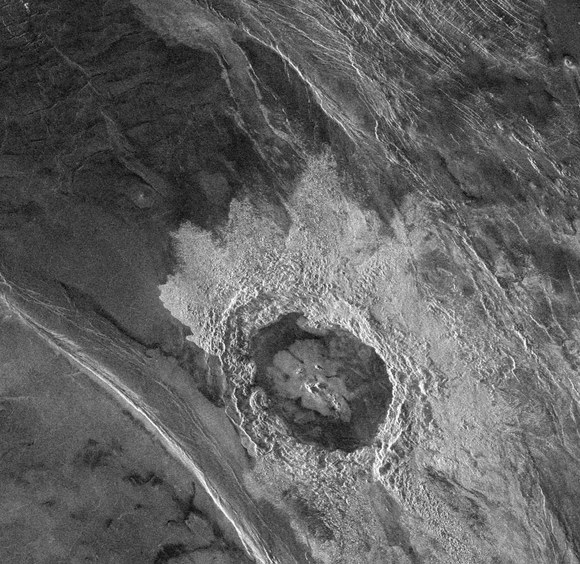Here’s this week’s ‘Where In The Universe’ challenge. I have a soft spot in my heart for craters. And the crater pictured here is one of the most gorgeous examples of a crater you’ll see. But just where in the solar system is this crater? When I worked at a science museum, one of the first activities I ever did with children was to make craters. Just take a small tub, put in a few cups of flour and sprinkle cocoa powder on top. Then let the kids lose with impactors of all sizes and have them drop them (from the same height at first) and let them observe the parts of a crater (the rim, ejecta, rays, and sometimes even the step-like features on the walls). The kids loved this activity (you get to throw things and make a mess), but they also learned a lot about craters and how craters can provide information about the history of a planet or moon. So, back to the image, and “A crater I may contemplate” (see the source of that quote below after you’ve made your guess). Is this crater on a planet or a moon, and which one?
This crater is on Venus, and is named Dickinson Crater. This crater is 69 kilometers (43 miles) in diameter, and located in the northeastern Atalanta Region of Venus at 74.6 degrees north latitude and 177.2 east longitude. This crater is quite complex, characterized by a floor with alternating dark and bright materials. Rough but bright ejecta extend all around the crater, except to the west,which may indicate that the impactor that produced the crater came from the west. Extensive radar-bright flows that emanate from the crater’s eastern walls may represent large volumes of impact melt, or they may be the result of volcanic material released from the subsurface during the cratering event.
The crater was named after Emily Dickinson, an American poet, who wrote a poem about volcanoes and craters:
Volcanoes be in Sicily
And South America,
I judge from my geography.
Volcanoes nearer here,
A lava step, at any time,
Am I inclined to climb,
A crater I may contemplate,
Vesuvius at home.
Emily Dickinson, ‘Volcanoes be in Sicily’, from The Single Hound: Poems of a Lifetime (Boston: Little, Brown, 1914), p. 125.
How’d you do?
Full size image from NASA Photojournal


How’d I do?
Poorly.
I knew it was a radar image, but thought it was a picture from Titan (even if I thought the definition was a bit suspicious, since Titan radar images are usually quite grainy), not from Venus.
What was the spacecraft? Magellan?
I’m sorry — I forgot to add what spacecraft took this image. Jorge was right: Magellan.
Nancy
My son and I guessed Earth. One of the features looked like a river bed to me.
Oh, well. The bad news is I’m something like 0 for 5.
But the good news is that my youngest son now plays!
I figured Venus – in the back of my mind it seems that many features there were named for famous women. As the book says, Women are from Venus, men are from Mars….so back to Mars (and Phoenix)…..still waiting for that “Imminent Discovery”…at least carbon compounds….and I’m not looking forward to seeing Carl Sagan on the Sunday marathon. He put a little too much of a wet blanket on the hopes for life on Mars for me to consider him objective.
Venus! Yes! I nailed it again. This was a good one. My only reservation was the resolution, but the wrinkles and channels dictated Venus or Titan. The eroded crater in the upper, right corner was the give-away. I don’t recall any craters on Titan. So far I’ve only missed one – the funny Earth clouds.
I look forward to the Challenge. Keep ’em coming!